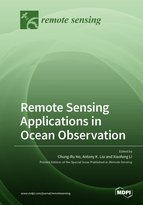Remote Sensing Applications in Ocean Observation
A special issue of Remote Sensing (ISSN 2072-4292). This special issue belongs to the section "Ocean Remote Sensing".
Deadline for manuscript submissions: closed (30 June 2022) | Viewed by 78306
Special Issue Editors
Interests: remote sensing; physical oceanography; global change; satellite oceanography
Special Issues, Collections and Topics in MDPI journals
Interests: ocean waves; oceanographic regions; remote sensing by radar; oceanographic techniques; radar imaging; synthetic aperture radar; ocean temperature; solitons; spaceborne radar
Interests: AI oceanography; big data; ocean remote sensing; physical oceanography; boundary layer meteorology; synthetic aperture radar imaging mechanism; multiple-polarization radar applications; satellite image classification and segmentation
Special Issues, Collections and Topics in MDPI journals
Special Issue Information
Dear Colleagues,
Since the launch of Seasat, TIROS-N, and Nimbus-7 satellites equipped with ocean observation sensors in 1978, there has been a new era of studying ocean from satellites. Today, ocean remote sensing data observed from satellites have been widely used in oceanographic studies. Drones and coast-based sensors are also used to observe ocean phenomena. Therefore, this Special Issue will cover all aspects of the application of remote sensing data/techniques in ocean observations using data from spaceborne, airborne, and ground sensors, as well as artificial intelligence and big data technologies. The scope of this Special Issue includes but is not limited to the use of ocean color sensors, radiometers, scatterometers, altimeters, radars, and LiDAR applications in ocean observations, such as internal waves, eddies, oil spills, algae blooms, sea ice, stray waves, upwelling, bathymetry, atmosphere–ocean coupling, etc. The use of drones to observe marine debris and coastal radars to observe ocean waves and coastal currents are also welcome.
Dr. Chung-Ru Ho
Dr. Antony K. Liu
Dr. Xiaofeng Li
Guest Editors
Manuscript Submission Information
Manuscripts should be submitted online at www.mdpi.com by registering and logging in to this website. Once you are registered, click here to go to the submission form. Manuscripts can be submitted until the deadline. All submissions that pass pre-check are peer-reviewed. Accepted papers will be published continuously in the journal (as soon as accepted) and will be listed together on the special issue website. Research articles, review articles as well as short communications are invited. For planned papers, a title and short abstract (about 100 words) can be sent to the Editorial Office for announcement on this website.
Submitted manuscripts should not have been published previously, nor be under consideration for publication elsewhere (except conference proceedings papers). All manuscripts are thoroughly refereed through a single-blind peer-review process. A guide for authors and other relevant information for submission of manuscripts is available on the Instructions for Authors page. Remote Sensing is an international peer-reviewed open access semimonthly journal published by MDPI.
Please visit the Instructions for Authors page before submitting a manuscript. The Article Processing Charge (APC) for publication in this open access journal is 2700 CHF (Swiss Francs). Submitted papers should be well formatted and use good English. Authors may use MDPI's English editing service prior to publication or during author revisions.
Keywords
- ocean remote sensing
- internal waves
- eddies
- oil spills
- algal blooms
- sea ices
- rogue waves
- upwelling
- bathymetry
- air-sea interaction
- marine debris






